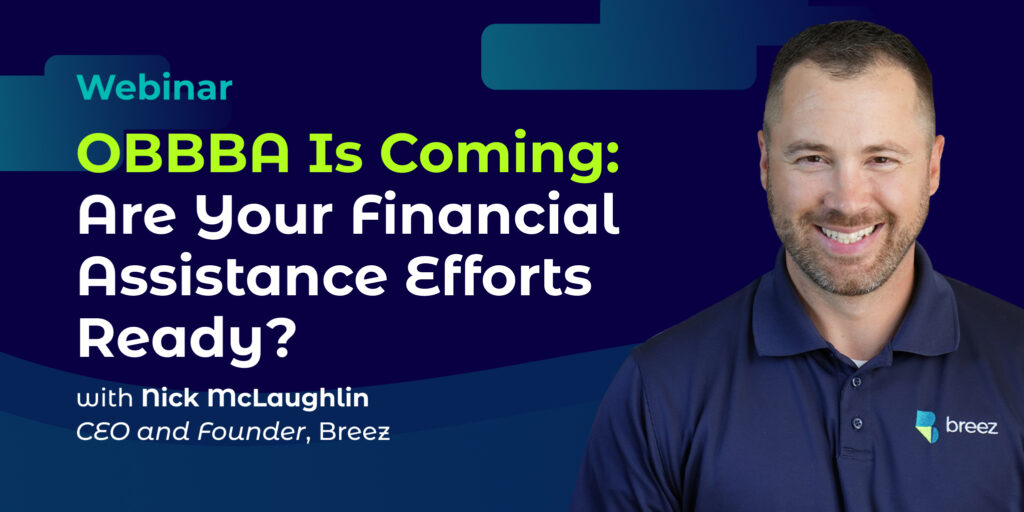See this article by Breez CEO Nick McLaughlin as it originally appeared in AAHAM’s The Journal.
In the aftermath of the pandemic, every nonprofit hospital in the United States is burdened with increasing amounts of bad debt. But many of those hospitals are underutilizing one of the best tools for fixing this problem — an already-established financial assistance program.
These programs can have a much larger impact than one might think. Households with income up to 400 percent of the federal poverty guideline may be eligible to receive at least a partial financial assistance discount on their hospital bills. For many people, falling into debt because of medical bills is entirely avoidable.
So while every nonprofit hospital has a financial assistance policy in place, what may not be on their radar are the hidden revenue opportunities in the accounts sent to bad debt collections. And it doesn’t require receiving payments from low-income patients. By identifying failure points in the traditional patient billing cycle, opportunities emerge to better serve both patients and hospitals.
The Traditional Patient Billing Cycle
It’s important to take a closer look at the traditional patient billing cycle. Point-of-service collection efforts are helpful, but after that the provider sends the claim to the payer and the bill to the patient.
Most patients who are able will either pay or set up payment arrangements. For those patients who cannot pay, traditionally they receive a series of in-house and third-party collection efforts. If there’s still an outstanding balance after those efforts, the account will end up with a collection agency, with 85-90 percent of accounts never getting collected.
Which Patients Pay and Which Do Not?
After the insurance company has paid its share, the patient is responsible for the rest. However, many insured patients qualify as underinsured, meaning the patient has insurance but still has out-of-pocket expenses that exceed their ability to pay.
According to a study conducted by TransUnion Healthcare, 30 percent of self-pay accounts generate more than 80 percent of the self-pay revenue for hospitals. Diving deeper, 41.5 percent of American households make more than 400 percent of the federal poverty level. These are the families and individuals who are gainfully employed and have discretionary income to put toward their medical bills, and a vast majority of them are paying.
Households making less than 400 percent of the federal poverty level are the ones who should be able to receive financial assistance from their hospital. These are also the patients that make up the vast majority of hospitals’ uncollectible bad debt.
Connecting these patients to financial assistance is a major opportunity for hospitals to improve their financial standing while also being a stronger partner for patients in their community.
Hidden Revenue Opportunities
There are several hidden revenue opportunities hospitals could capitalize on by better leveraging financial assistance programs.
1. Partial Discounts for Patients with Limited Ability to Pay
The simplest opportunity to use a financial assistance program to increase the amount of revenue collected from eligible patients is to charge less. Smaller bills are more affordable bills, and collecting 50 percent of $500 is much more than 5 percent of $2,000.
Systematically discounting the bill according to the patient’s ability to pay gives the hospital a higher chance of getting something instead of nothing. Everybody comes out ahead.
2. Reduce the Financial Burden of Care to Increase Revenue
This opportunity can be broken down into two parts. The first is financial assistance as a competitive advantage, and the other is financial assistance to increase utilization.
Increasing price transparency helps patients make decisions about where they go for care. Patients are naturally concerned about their deductibles and out-of-pocket costs. By creating education and awareness around financial assistance, new patients will choose the hospital they know will work with them over one that doesn’t promote charity care programs or make them easily accessible.
Nonprofit hospitals are focused on creating healthier communities. But what happens when patients start avoiding care because of cost? If patients know they will receive care at a cost they can afford, more patients will come in for routine care. Creating healthier communities decreases the risk of larger, more expensive, potentially life-threatening health challenges down the road. Reducing costs for charity-eligible patients will increase patient volume for preventative care.
3. Engage Eligible Patients Who Do Not Have Insurance
It’s important for true self-pay patients to complete the application for financial assistance. This benefits the hospital by engaging those patients, and getting their updated contact and insurance information on file. If the patient did not provide their current insurance at the visit in question, this extra engagement opportunity may lead to the hospital receiving insurance reimbursement for that service.
To engage with patients, hospitals need to make the process easier. Proof of income and bank statements are all that is needed to determine program eligibility. Burdensome and detailed documentation requirements prevent patients from engaging with hospital financial assistance programs and getting the care they need. The easier it is to sign up, the better chance the hospital will see increased revenue.
Hospital financial assistance programs can go a long way toward making life easier for both patients and hospitals. A slightly different perspective and approach will uncover hidden revenue opportunities.



